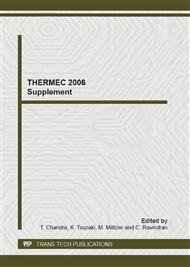p.251
p.255
p.261
p.267
p.275
p.281
p.287
p.293
p.299
Hydrogen Detection by a GaAs-Based Transistor with a Palladium (Pd) Thin Film Gate Structure
Abstract:
By combining the advantages of a catalytic palladium (Pd thin film) with a high-performance GaAs-based transistor, an interesting hydrogen sensor is fabricated and demonstrated. For the studied device, a 50 Å undoped GaAs cap layer is grown to prevent the Al0.24Ga0.76As Schottky layer from oxidizing and to suppress the Fermi level pinning effect. The sensing mechanism can be described as the dissociation of hydrogen molecules and the polarization of hydrogen atoms. The drain-source variation ΔIDS is caused by the polarization of a dipolar layer resulting in the modulation of the gate potential and carrier density level. Experimentally, a high hydrogen detection sensitivity SJ value of 275.8 mA/mm-ppm H2/air can be obtained under the 14ppm H2/air gas. Even under a very low hydrogen concentration (≤4.3 ppm H2/air) at 303K, the considerable current variation can be observed. Moreover, the fast hydrogen response is found. Therefore, the studied device reveals the promise for high-performance hydrogen sensor applications.
Info:
Periodical:
Pages:
275-280
Citation:
Online since:
February 2006
Authors:
Price:
Сopyright:
© 2007 Trans Tech Publications Ltd. All Rights Reserved
Share:
Citation:


